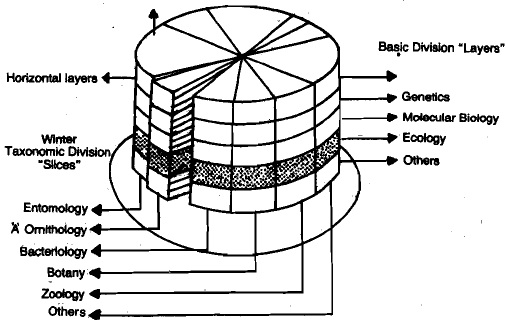Relationship of Ecology with Other Disciplines of Biology
In order to understand the scope and relevance of ecology let us consider its position in relation to other biological disciplines, with the help of a diagram in the shape of a cake see Figre shown below.

This hypothetical biological cake has several horizontal layers representing the 'basic' divisions of biology, common to all organisms - morphology, physiology, genetics, ecology, evolution, molecular biology, developmental biology etc. These horizontal layers are divided vertically into unequal 'taxonomic slices' of biology as well. Each such slice is labelled by the specific kinds of organism. The thicker slices represent large divisions of biology and are labelled Zoology, Botany, Bacteriology etc. The thinnq slices are labelled a Phycology, Ornithology, Protozoology as they deal with specific type of organisms.
Let us consider slice 'A', i.e. ornithology - the study of birds. This slice with its horizontal layers of molecular biology, developmental biology, genetics, ecology etc. indicates that there are different approaches to the study of birds. The approach may be molecular or ecological, or of any other type, or a combination of two or more approaches. The 'biological cake' analogy helps us appreciate that ecology is a basic division of biology.
It is often important to restrict work to certain taxonomic species or groups because different kinds of organisms require different methods of study. For example, one cannot study pigeons and bacteria using the same methods. However, the modem ecological principles have provided many unifying concepts such as energy flow, nualent cycling and population dynamics for comparing diverse ecosystems.